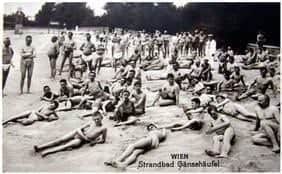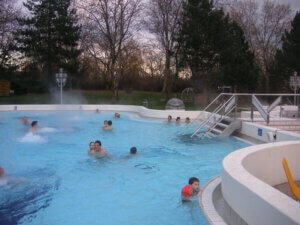Also in Vienna, at the beginning of the 20th century. noble pallor – preserved under sunshades – the beauty rule. Both church and doctors agreed to expose as little skin as possible to the sun. But then came Florian Berndl. Born in the Waldviertel, son of a natural midwife, he came to Vienna as a nurse in the General Hospital and realized: People need sun, air and water to stay healthy.
The Viennese actually had little of that at the time. Cramped, dreary apartments, long working hours and inadequate hygiene took their toll on the Viennese population.
During hikes, he noticed an island in the Old Danube , which he leased in 1900 for 15 guilders a year . He moved there with his wife and sons into a straw hut and began to realize his ideas of a natural way of life. Freedom for body and mind was his motto.
For an entrance fee, one could enjoy sand baths, mud wraps, herbal healing baths or massages, pedicures and ablutions with him. Through specially printed postcards and brochures, a kind of cure and body care was offered. There were more and more Berndl disciples, men and women, who enjoyed air baths in so-called “morality dresses”, plain short trousers for him, loosely falling shirt for her or even in Adam’s costume (!) and refreshed themselves together in the Old Danube.
It did not take long before the honorable Viennese society was outraged by the scandalous and immoral goings-on at the Gänsehäufel. Where farmers used to graze their geese, a spa had now sprung up and was becoming increasingly confusing. It had become downright chic to be on the
“Sin Island” to defy the moral codes of the time and demonstrate modern open-mindedness.
When he sold refreshments to the public and could not produce a permit, the city quickly cancelled his lease in 1905. By 1907, the former natural paradise had become a public lido . Berndl returned as a bath attendant.
He still founded the first allotment garden settlement on the Old Danube and called it “New Brazil” . But the project slipped away from him and the “First Viennese Pleasure and Utility Garden Association” became independent. Berndl first became head bath attendant at the Gänsehäufel, later also supervisor of the children’s recreation center built there for socially needy and sick children. Despite being banned, he continued with his idiosyncratic naturopathic treatments, which ended in a conviction for quackery in 1913 and led to his dismissal and delogation .
The Gänsehäufel became the favorite swimming pool of the Viennese . 46,000 m² of meadow area, 305 m long sandy beach, chic beach chairs, water slides and gymnastic equipment were offered. The bath was designed for 600 visitors. Often the blue flag was already hoisted at Praterstern to indicate that there was no point in continuing the journey: the bath was already at capacity.
The bathing ticket was already bought at the Kaisermühlner Ufer. A clean towel was included in the price. High wooden fences separated the women’s area from the men’s area and the area for families. The family bath was also open to childless married couples. A marriage certificate did not have to be presented …
In 1911, 400,000 guests were counted. After the 1st World War, the separation of the sexes was abolished, but there remained the possibility to retire to the ladies’ or men’s baths. Bands played for the 5 o’clock tea, dancing, fashion shows, cabaret, tennis and table tennis, and restaurants spoiled the bathers.
130 aerial bombs ended this equipment in the 2nd World War. But already in 1950 it was reopened. Bigger and more beautiful than ever, with 330,000 m², a new wave pool – the first in all of Europe – and numerous play and sports facilities. Only the sand had given way to meadows, almost to the water. Since 1981 there is also an official nudist area with its own restaurant…
The general renovation in 2004 cost over 7 million euros. Today it is a modern activity center with a high ropes climbing course. 31,533 visitors were counted on June 22, 2016.
Time Travel Tip:A summer swim at the lido Gänsehäufel is highly recommended, especially the west beach, where you can swim in the natural water of the Old Danube and see a great sunset of the modern skyline of Vienna. The bath is open in summer until 20h.





